This article is all about helping parents like you with practical examples of ABA (Applied Behavior Analysis) extinction techniques to manage your children's behavior effectively. By systematically withholding reinforcement for those pesky unwanted behaviors—like ignoring tantrums while cheering on positive actions—you can create a nurturing environment that encourages your little ones to improve over time.
Let’s explore this together! By focusing on the right strategies, you’ll find that fostering good behavior becomes a rewarding journey. Remember, every step counts, and we’re here to help you every step of the way!
Understanding and managing children's behavior can often feel like navigating a complex maze. For parents seeking effective strategies, it’s crucial to find the right tools. One of the most powerful techniques in this journey is ABA extinction, which focuses on reducing unwanted behaviors by systematically withholding reinforcement.
Let’s dive into nine practical examples of ABA extinction that can empower you to foster positive behavior changes in your children. But remember, the path to success isn’t always easy—how can caregivers stay consistent and patient when faced with initial behavioral surges? Exploring these techniques not only provides insight but also opens the door to transformative growth within your family dynamic.
We’re here to help you every step of the way! Let’s explore this together!
At Rori Care, we understand that parenting can be challenging, especially when it comes to behavior management. That's why we use transformative extinction techniques as an ABA extinction example in therapy to help modify actions effectively. These techniques are an ABA extinction example, focusing on systematically withholding reinforcement for unwanted behaviors, which leads to a gradual decrease in those actions.
For example, if your little one throws a fit to get attention, consistently ignoring the outburst while praising positive behaviors can really help reduce those tantrums over time. This organized approach not only allows parents to actively participate in their child's behavior modification journey but also fosters a nurturing environment that supports growth and learning.
Research shows that family involvement is key in ABA therapy, making interventions even more effective. By understanding and applying these reduction methods, parents can create a steady structure that encourages positive behavioral changes. This, in turn, leads to better communication and social interactions for your child.
The collaborative nature of this method enhances family interactions, reduces stress, and creates a supportive atmosphere where children can truly thrive. Let’s explore this together and see how we can make a difference in your family’s journey!
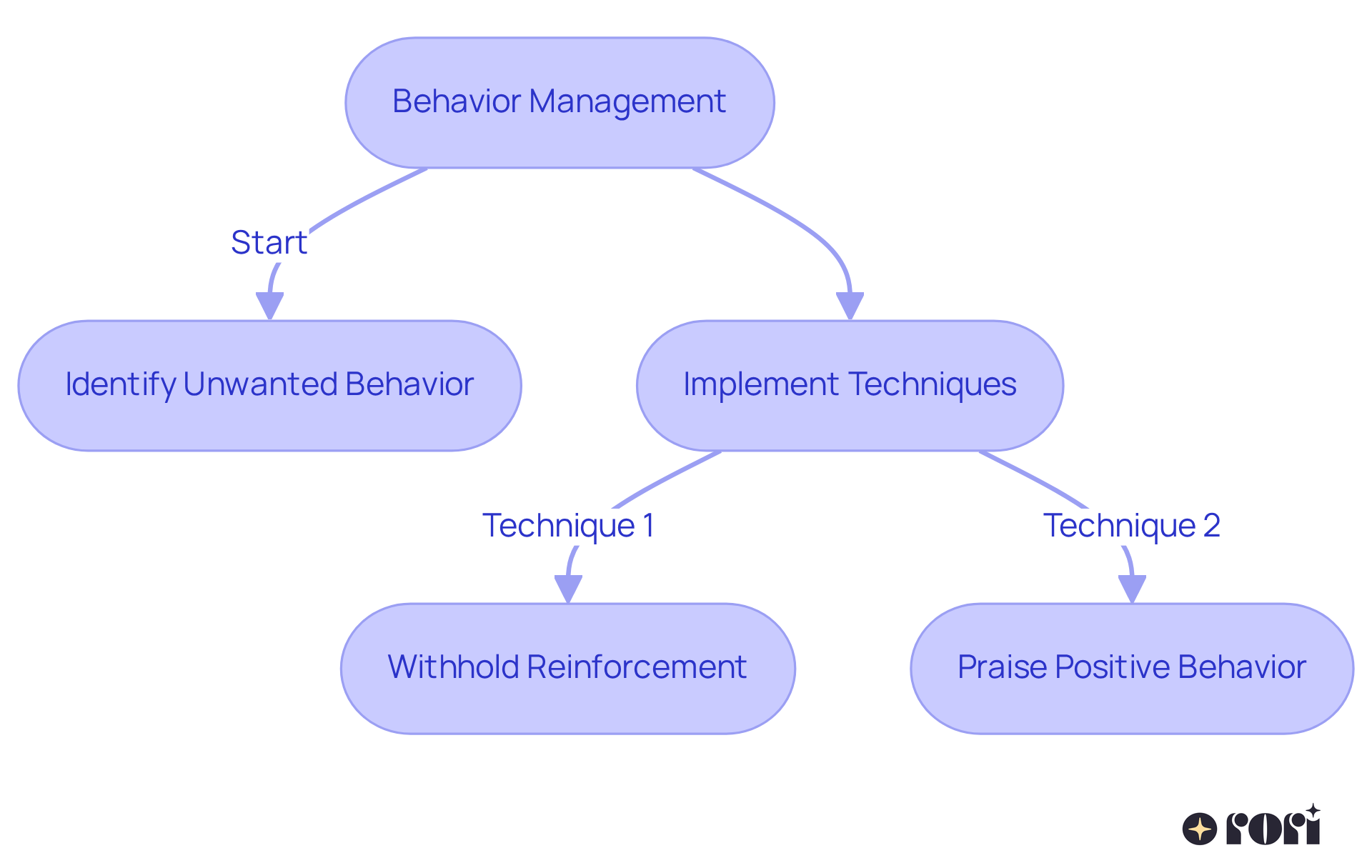
In Applied Behavior Analysis (ABA), an aba extinction example illustrates a key process aimed at reducing those pesky unwanted behaviors by simply stopping the reinforcement that once supported them. Imagine a young person engaging in an action that used to earn them a reward, like getting praised for interrupting conversations. When that reinforcement is removed, you’ll likely see a gradual decrease in that behavior. An aba extinction example occurs when a child receives attention for throwing tantrums, and by withholding that attention, it can lead to fewer outbursts over time. This principle is super important for parents, as it lays the groundwork for effective management strategies.
Recent studies have shown that all types of elimination methods can successfully cut down on these issues over time. But here’s the catch: right after removing reinforcement, you might notice a little spike in those unwanted actions, often called an initial surge. This highlights the need for caregivers to stay consistent and patient throughout the process—your dedication is key to long-term success!
Effective management techniques that use the removal of reinforcement include:
By understanding the role of challenging behaviors, caregivers can implement specific interventions that not only reduce negative actions but also promote positive alternatives.
And let’s not forget about the importance of caregiver education! By boosting their understanding of ABA principles and strategies, caregivers become better equipped to provide the right support at home. This not only complements professional interventions but also promotes consistency. When caregivers are informed, it leads to better behavioral outcomes. Active involvement and alignment with therapeutic strategies often result in more effective and lasting improvements. Plus, it can reduce stress and enhance family dynamics, empowering caregivers to feel more confident in their roles.
Monitoring progress through data collection is essential! It helps caregivers evaluate how effective their strategies are and make any necessary tweaks. For instance, if you notice that a child’s outbursts initially increase, it’s important to stick with the elimination strategy—consistency is crucial for lasting success. By embracing these principles and empowering themselves with knowledge, parents can create a nurturing environment that encourages positive behavioral changes. Let’s explore this together!
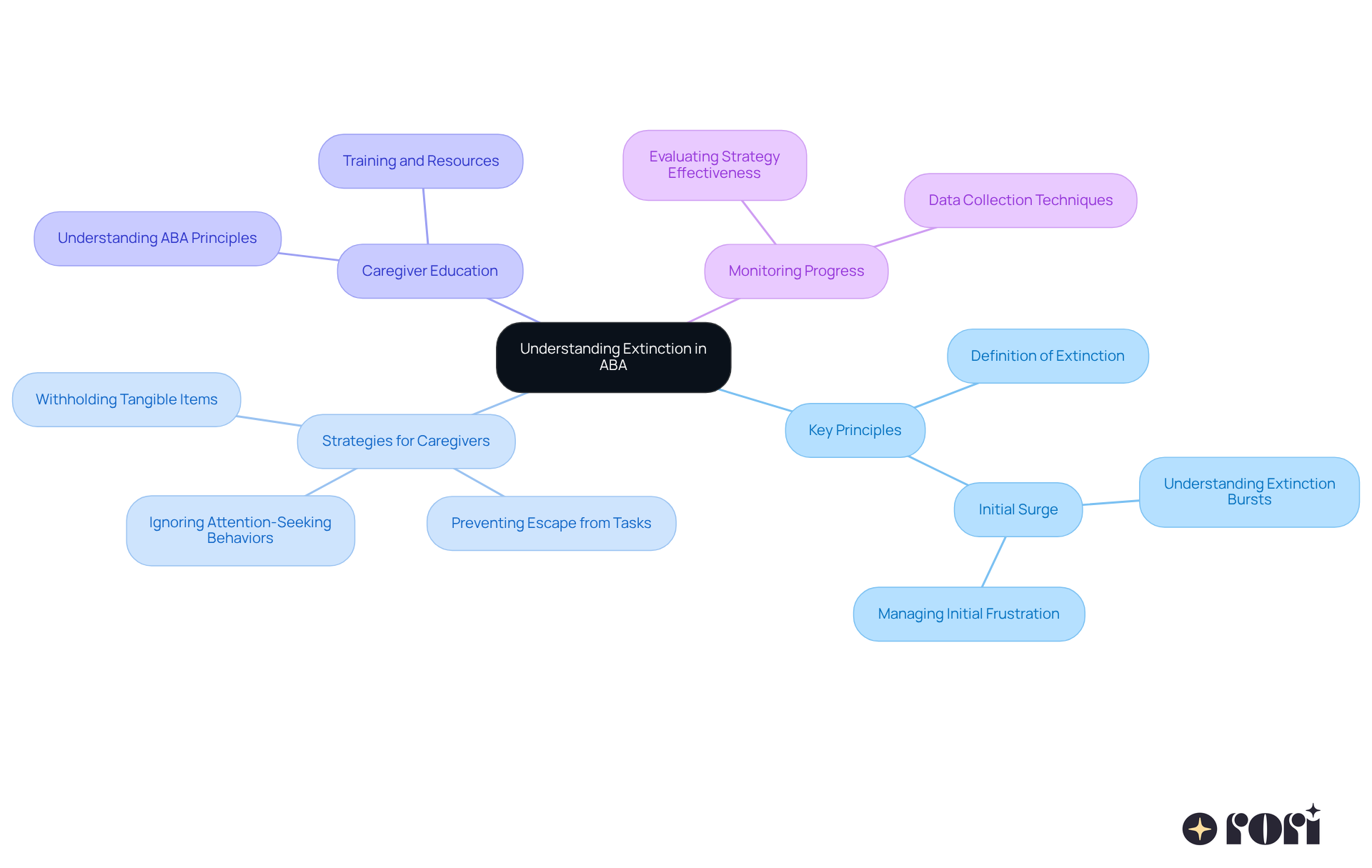
When managing challenging behaviors in children, an ABA extinction example of extinction procedures in ABA therapy can be incredibly helpful. Let’s dive into some effective strategies that can make a real difference!
Ignoring Tantrums: Picture this: a child throws a tantrum just to get attention. By consistently ignoring this behavior and instead offering positive reinforcement for calm actions, you can significantly reduce those tantrums. This teaches kids that disruptive actions won’t get them what they want, which is a valuable lesson!
Withholding Rewards: Now, imagine a young one who screams for a toy. Instead of giving in, try reinforcing quieter requests instead. This approach emphasizes the importance of teaching kids to express their needs in more appropriate ways, which can be a game-changer.
Planned Ignoring: There are times when kids seek attention through disruptive behavior. In those moments, planned ignoring can work wonders. For instance, if a child yells during dinner, parents can continue their conversation without acknowledging the outburst. Over time, this can lead to fewer interruptions during meals.
Real-Life Application: Let’s consider a child named Brian who screams for attention from his teachers. By applying a method that involves withdrawing attention when he screams, caregivers can help him realize that this behavior won’t bring the desired interaction. Initially, he may scream even louder as he tries to regain attention, but with consistent application of this technique, the overall frequency of his screaming will likely decrease.
Expert Insights: Research shows that effective communication and consistency among caregivers are vital when using these techniques. Proper training and ongoing support from licensed ABA practitioners ensure that these methods are applied ethically and effectively, maximizing their potential for positive change.
By understanding and implementing the ABA extinction example techniques, you can create a more adaptive environment for your children. This ultimately leads to improved behavioral outcomes. Let’s explore this together and see how we can support each other on this journey!
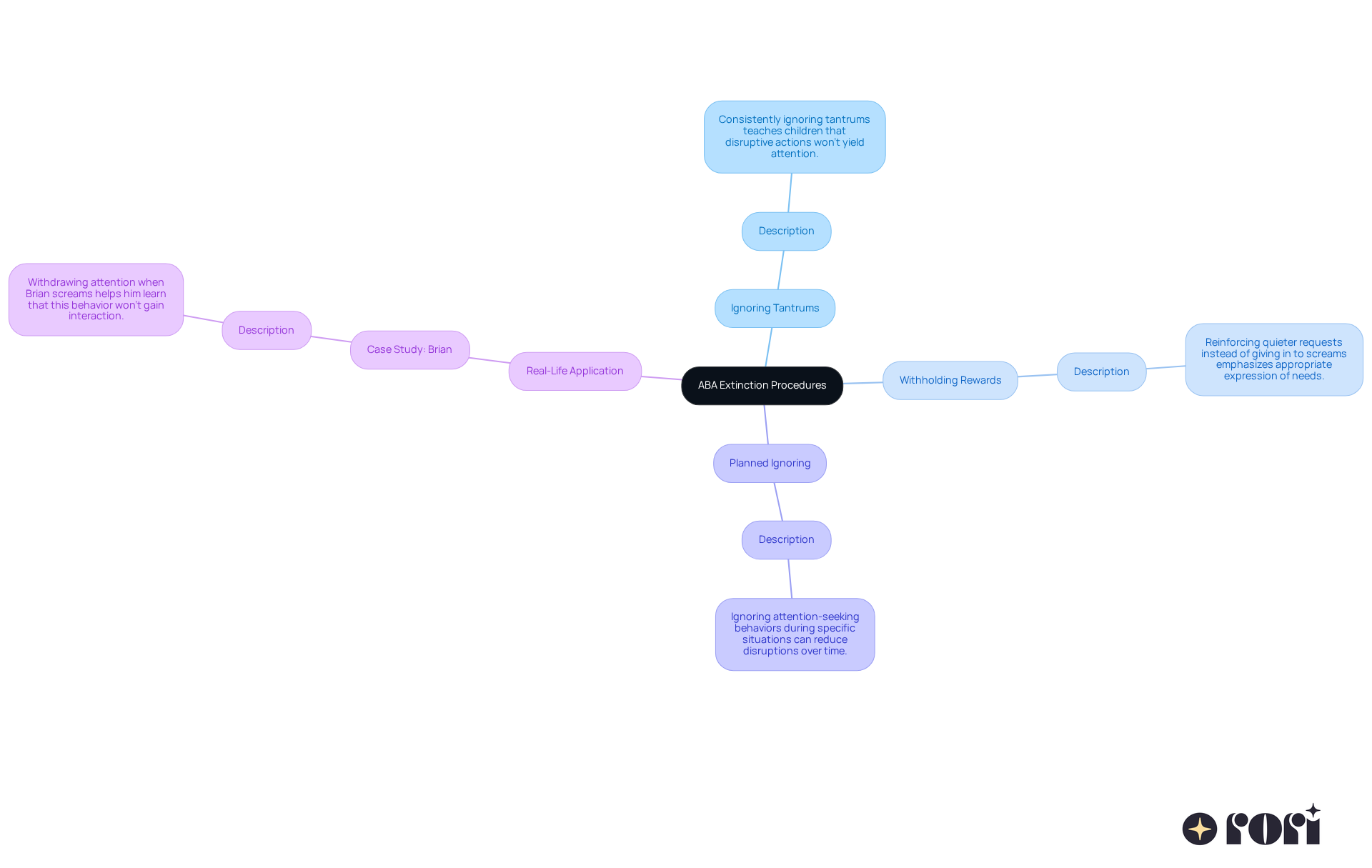
Extinction bursts can be a bit overwhelming, can't they? They represent those temporary spikes in behavior when reinforcement is taken away. But don’t worry! Here are some friendly strategies for parents to handle these bursts, emphasizing how important your involvement and education are:
By using these approaches, caregivers can navigate the challenges of behavioral surges, creating a nurturing environment that fosters positive behavior change. Plus, through caregiver education and services like individual therapy at Rori Care, families can deepen their understanding of ABA principles. This knowledge empowers you to make informed choices that positively impact your child’s progress. Let’s explore this together!
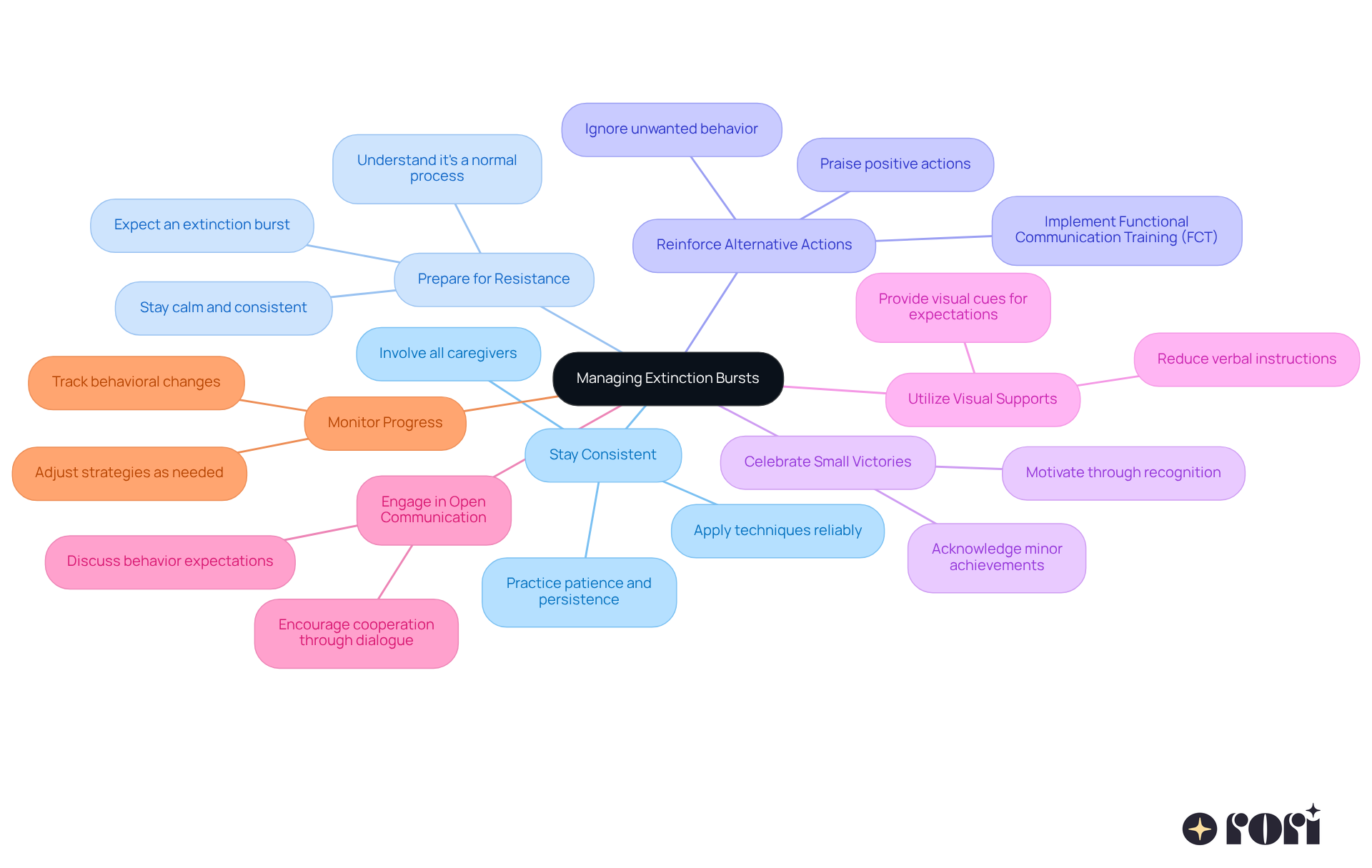
When it comes to implementing extinction techniques, it's important for parents to follow some ethical guidelines that really make a difference:
Informed Consent: First and foremost, all caregivers should fully understand the extinction process and agree to it before moving forward. This ensures that everyone involved knows what methods are being used and how they might affect the young person. Informed consent is not just a legal requirement; it's an ethical one too! Educating caregivers helps them make informed choices that can positively impact their child's progress.
Youth's Emotional Well-Being: Keeping an eye on the youth's emotional reactions during the extinction process is super important. Regular progress monitoring is needed to see how the treatment is affecting them. If you notice any signs of distress, it might be time to adjust your approach to better support their emotional well-being. When caregivers are active participants and trained in ABA principles, it leads to better behavioral outcomes and a more attentive approach to the young individual’s needs.
Avoid Harmful Practices: Remember, extinction techniques should never involve punishment or harmful practices. The goal here is to reduce unwanted behaviors while creating a safe and supportive environment for the young one. It’s essential to uphold their dignity and well-being in every intervention. Practitioners have an ethical obligation to prioritize the welfare and best interests of their clients. When caregivers are empowered with knowledge and skills from education, they can confidently advocate for their child's best interests, ensuring that interventions are both ethical and effective.
Let’s explore this together! Your role as a caregiver is crucial in navigating these challenges, and we’re here to help you every step of the way!
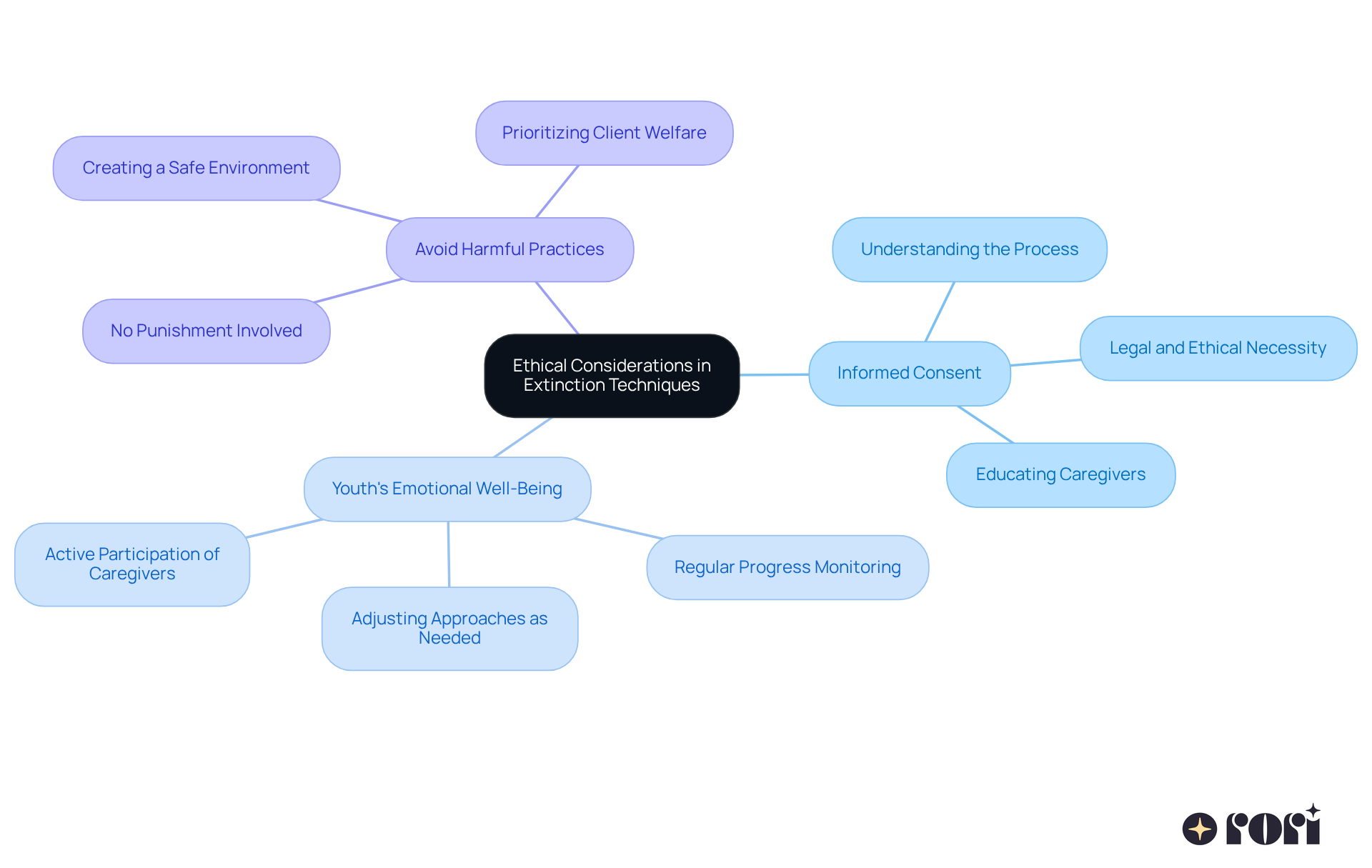
Data-driven strategies are super important in ABA therapy for keeping track of how well elimination procedures are working. Let’s look at some friendly methods parents can use:
Let’s explore this together! Remember, we’re here to help you every step of the way!
![]()
Let’s talk about some common misconceptions about extinction in ABA therapy that can lead to confusion:
Extinction Equals Punishment: Many people think that extinction is just another way to punish a child. But here’s the truth: extinction is all about withholding reinforcement, not punishment. This approach aims to eliminate unwanted behaviors by taking away the rewards that encourage them, creating a more positive environment for everyone. Educating caregivers is so important here! When guardians understand these principles, it helps reduce stress and improve family dynamics.
Neglecting Actions is Neglect: Some parents worry that ignoring a child’s actions might be neglectful. However, planned ignoring is a thoughtful strategy designed to reduce unwanted behaviors while promoting positive alternatives. This technique helps children learn that certain actions won’t get them the attention or reinforcement they seek. With proper training, caregivers can confidently use this method, knowing it’s part of a structured approach to managing behavior.
Immediate Results: It’s common for parents to expect quick changes when using extinction techniques. But it’s crucial to recognize that changing behavior takes time and consistency. Sometimes, you might even see an initial spike in unwanted actions before things start to improve. Patience and commitment are key! Research shows that '90% of youngsters receiving the recommended hours of ABA therapy with active caregiver participation experience significant progress.' This highlights the importance of sticking with the elimination strategies. By understanding that behavior change is gradual, empowered caregivers can stay committed to the process.
By understanding these misconceptions, parents can effectively apply elimination methods, fostering a supportive atmosphere for their child’s growth and development. With the right education and support, caregivers can make informed decisions that positively impact their child’s progress. We’re here to help you every step of the way!

Working together with ABA therapists is essential for effectively applying cessation strategies. Here are some key ways to enhance this partnership:
Regular Communication: Keeping those lines of communication open with your child's ABA therapist is so important! Discussing progress, challenges, and necessary adjustments in the aba extinction example approach helps ensure that everyone is on the same page. This ongoing dialogue makes a world of difference in aligning strategies.
Training and support: Have you thought about asking your therapist for training on how to implement an aba extinction example at home? Rori Care offers specific caregiver education programs that help create consistency between therapy sessions and home practices. This is vital for effective behavior modification! Understanding ABA principles allows you to make informed choices that can positively influence your child's progress.
Feedback Loop: Sharing feedback with the therapist about what strategies are working and which ones aren't is crucial. This collaborative feedback helps tailor an approach that meets your child's unique needs, ultimately improving the overall effectiveness of the therapy.
Research shows that only 15% of insured minors referred for ABA treatment receive the recommended hours. This highlights how vital active involvement and communication are! When ABA therapy is implemented effectively, it boasts an impressive over 89% success rate in enhancing various developmental aspects. By taking advantage of insurance-covered payment options, families can ensure they receive the necessary support. Remember, "Every step forward is a step toward success!" This really emphasizes the value of your involvement in the therapy process. For practical use, consider scheduling a weekly check-in with your therapist to discuss your child's progress and any changes needed in the intervention strategies. Let’s explore this together!
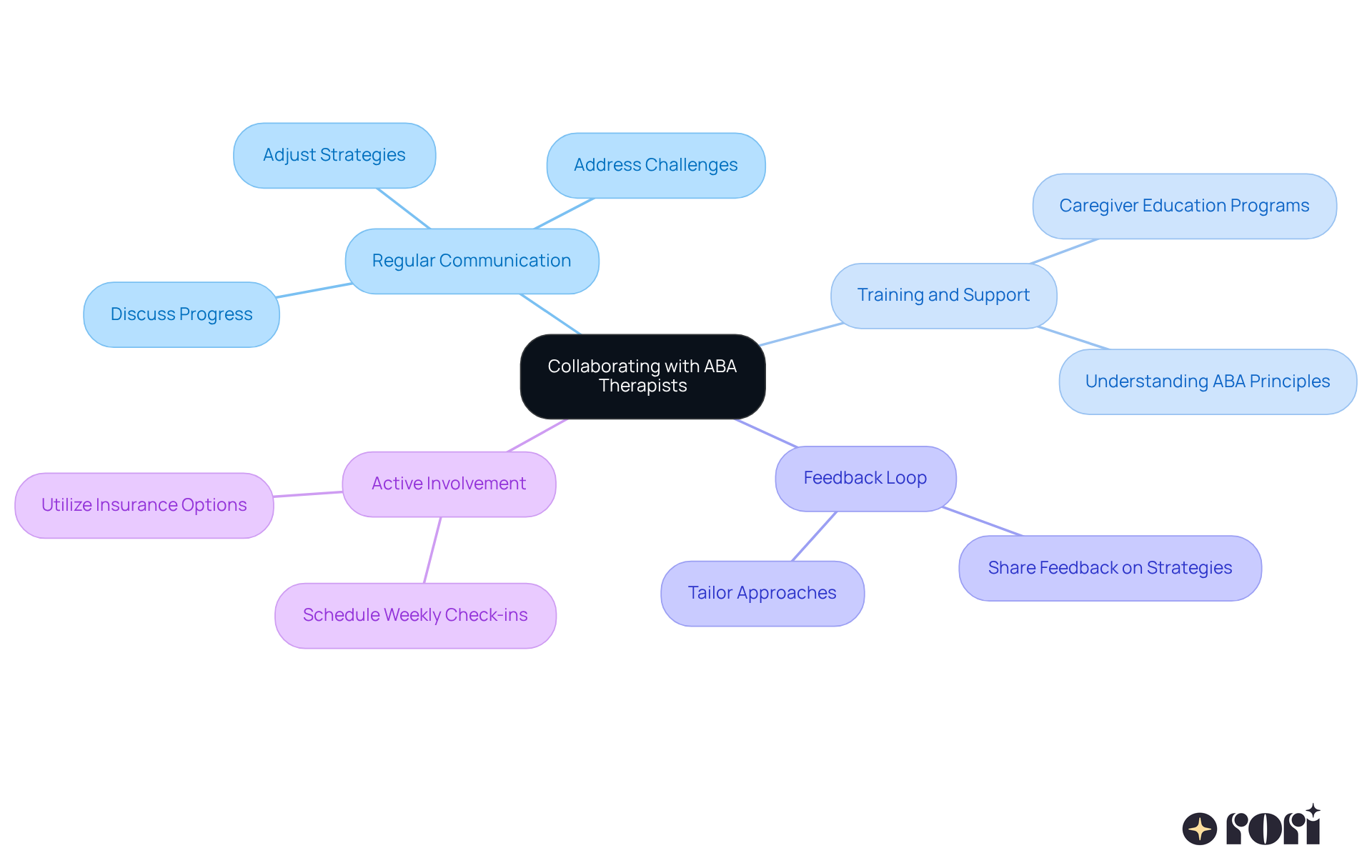
When considering the aba extinction example techniques in ABA therapy, it's helpful to think about the outcomes in two ways: immediate and long-term effects.
Immediate Outcomes: At first, you might notice a spike in the undesired behavior, often called an extinction burst. This is a normal reaction as your child tests the new boundaries you've set. Staying calm and steady during this phase is crucial; it marks the beginning of the change process. Understanding these shifts is key for parents, caregivers, and therapists as they work together to create a supportive environment for behavior change. By learning about ABA principles, you can provide even better support at home, complementing professional help and ensuring consistency.
Long-Term Outcomes: With ongoing use of these techniques, you can expect to see a gradual decline in unwanted behaviors, which acts as an aba extinction example, paired with an increase in positive actions. Over time, this leads to improved overall behavior and social skills, paving the way for greater independence for your child. Keeping track of these behavior changes is essential; it gives you insights into how well the extinction process is working and allows you to make any necessary adjustments. When done right, it can significantly reduce challenging behaviors while promoting more suitable alternatives. Equipped with knowledge and skills, you can make informed decisions that positively impact your child's journey.
It's also important to keep an eye on any changes in your child's behavior, whether in frequency or intensity, during and after implementing these techniques. Remember, emotional reactions like frustration or sadness can arise during this process, and recognizing this is vital for understanding your child's experience. To support your child effectively, it's encouraged to maintain open communication about the extinction process and seek guidance from ABA professionals. This way, you empower yourself and enhance your ability to support your child's development.
Let’s explore this together! We’re here to help you every step of the way!

For parents eager to deepen their understanding of the aba extinction example techniques, there are several valuable resources just waiting to be explored!
Books: "Applied Behavior Analysis" by Cooper, Heron, and Heward dives deep into ABA principles, offering effective strategies for implementing extinction. It’s a must-read for anyone looking to get a solid grasp on the subject!
Online Courses: Have you checked out platforms like Rori Care? They offer customized online courses that equip caregivers with vital ABA techniques, enhancing your ability to support your child's development. It’s a fantastic way to learn at your own pace!
Support Groups: Engaging with local or online support groups can be a game changer. Sharing experiences and strategies with other caregivers fosters a sense of community, making it easier to implement extinction techniques in daily life.
Studies show that guardians who participate in organized education, like online classes, see a significant boost in their understanding of the aba extinction example. This leads to more effective management strategies! Plus, case studies reveal that parents who utilize recommended books and courses often notice improved outcomes in their children's behavior and social skills.
Let’s explore this together! We’re here to help you every step of the way!
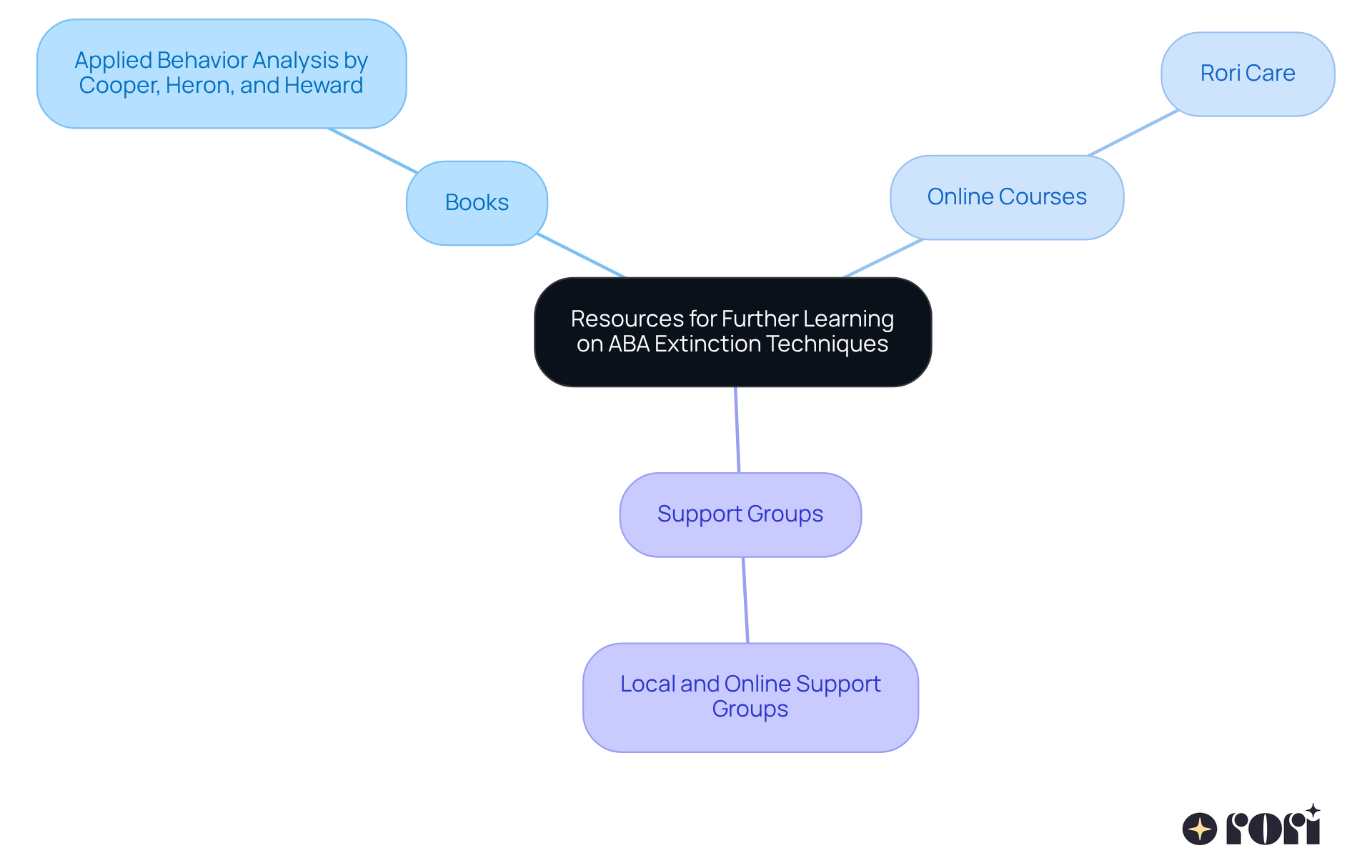
Understanding and applying ABA extinction techniques can truly transform behavior management for parents. By systematically withholding reinforcement for unwanted behaviors, caregivers can create a more supportive environment that encourages positive actions and gradually reduces challenging behaviors. This approach not only empowers parents but also enhances family dynamics, allowing children to thrive in a nurturing setting.
The article highlights various practical examples of extinction procedures, like ignoring tantrums and planned ignoring, along with strategies for managing those tricky extinction bursts. It emphasizes the importance of:
to ensure that these techniques are implemented ethically and effectively. Plus, it underscores the necessity of data-driven approaches for tracking progress, which helps caregivers make informed adjustments to their strategies.
Ultimately, the journey of behavior modification through ABA extinction requires patience, commitment, and a willingness to learn. By embracing these principles and actively participating in their child's development, parents can create lasting positive changes. Engaging with educational resources and support networks further strengthens this process, paving the way for improved outcomes in children's behavior and social skills. Remember, your commitment to understanding and applying these techniques can lead to a brighter future for both children and their families. Let’s explore this together!
What is the purpose of transformative extinction techniques in ABA therapy?
Transformative extinction techniques aim to modify unwanted behaviors by systematically withholding reinforcement, which leads to a gradual decrease in those behaviors.
How do parents participate in their child's behavior modification journey using these techniques?
Parents can actively participate by consistently ignoring unwanted behaviors while praising positive behaviors, creating a nurturing environment that supports growth and learning.
What is an example of an ABA extinction technique?
An example is ignoring a child's tantrums for attention while reinforcing calm behaviors, which helps reduce the frequency of those tantrums over time.
What is the initial surge in behavior when using extinction techniques?
The initial surge refers to a temporary increase in unwanted behaviors that may occur right after removing reinforcement, highlighting the need for caregivers to remain consistent and patient.
What are some effective management techniques in ABA therapy?
Effective techniques include ignoring attention-seeking behaviors, preventing children from escaping tasks, and withholding tangible items during outbursts.
Why is caregiver education important in ABA therapy?
Caregiver education is crucial as it equips them with the knowledge to support their child effectively at home, promoting consistency and better behavioral outcomes.
How can caregivers monitor progress in ABA therapy?
Caregivers can monitor progress by collecting data on behaviors to evaluate the effectiveness of their strategies and make necessary adjustments.
What is planned ignoring and how is it used?
Planned ignoring involves intentionally not acknowledging a child's disruptive behavior, such as yelling during dinner, which can lead to fewer interruptions over time.
Can you provide a real-life example of applying an ABA extinction technique?
For instance, if a child named Brian screams for attention from teachers, caregivers can withdraw attention when he screams. Although he may initially scream louder, consistent application of this technique will likely decrease his overall screaming frequency.
What role do licensed ABA practitioners play in implementing these techniques?
Licensed ABA practitioners provide training and ongoing support to ensure that extinction techniques are applied ethically and effectively, maximizing their potential for positive change.